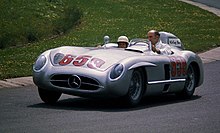List of Nordschleife lap times (racing)
Its over 20.8 km (12.9 mi) long old section dating from 1927, was truncated in 1982 as international championships had started to boycott the track after 1976.
The track was inaugurated in 1927 with the Eifelrennen events for bikes and cars, taking place on the combined Nordschleife and Südschleife, with a length of 28.265 km (17.563 mi).
Also, the Nürburgring in the Eifel mountains became notorious for frequent bad weather, and due to its length with lap times of 10 minutes, conditions could change significantly in the meantime.
Smaller races resumed in the late forties, but Germans and Germany remained excluded from major sports events until 1951.
Two rule changes brought less powerful machinery, and the Le Mans disaster in 1955 led to the cancellation of many GPs in that year, including the German.
After three years of progress, including a revival of the mid-engine layout pioneered by Auto Union, the 9 minutes barrier was easily beaten despite small 1500cc engines with less than 200 hp, similar to the power of cars three decades earlier.
The Hohenrain chicane (and 25 meters extra, now 22.835 km (14.189 mi)) was added in early 1967 to lower entrance speed to the Start/Finish straight and the pitlane.
Lap times were affected only initially, as technical progress, especially aerodynamic aids, made the cars significantly faster in the years to follow.
Due to safety concerns, the Formula One drivers on short notice forced a move of the 1970 German Grand Prix to the Hockenheimring.
By early 1971, the Nordschleife track had been resurfaced, several bumps and jumps (e. g. Brünnchen) had been removed, and the hedges had been replaced by Armco barriers.
In late 1982, after the 24 Hours race, the start/finish loop with the pit facilities section was destroyed, putting an end to the classic 22.8 km layout.
As the 24h Nürburgring weekend includes various supporting races, the organizers use parts of the track as additional paddock area.
In 2004, the VLN track variant was used, and the Dunlop section was used as paddock area, but access to the actual pits was impractical.
After the VLN 4h endurance race[211] of 28 April 2007 which hosted also a BMW publicity day for fans, Nick Heidfeld drove a BMW Sauber F1.06 Formula One car around the Nordschleife and short GP-track, as used in VLN races, with a track length of 24.433 km (thus comparison with 1970s times is difficult).
For safety reasons, BMW had announced that the car was slowed with hard demonstration tires, maximum ride height, and 275 km/h top speed limited by the transmission.
Similar to the Isle of Man TT, amateur enthusiasts continued to compete on the old track in endurance events.
In the 1990s, only the so-called Zuverlässigkeitsfahrt (Zuvi, reliability run) series remained, for amateurs on road legal stock bikes.

Black : modern GP track (layout since 2002, ca. 5km)



during practice at the Nürburgring







